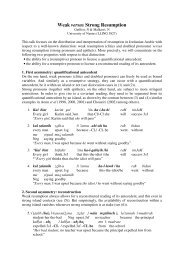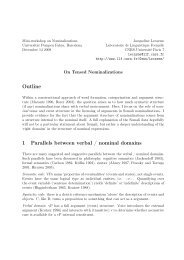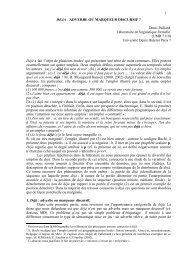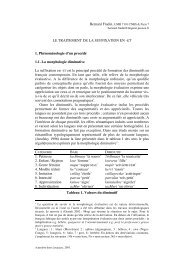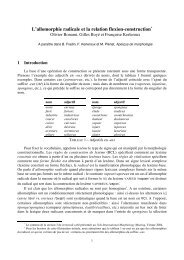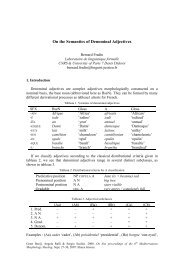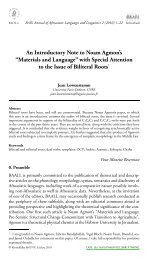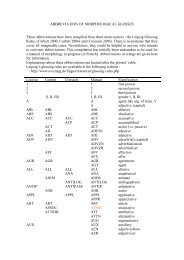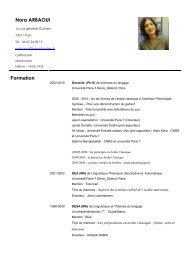Article and Bare predication in English and Dutch: A semantic ...
Article and Bare predication in English and Dutch: A semantic ...
Article and Bare predication in English and Dutch: A semantic ...
Create successful ePaper yourself
Turn your PDF publications into a flip-book with our unique Google optimized e-Paper software.
<strong>Article</strong> <strong>and</strong> <strong>Bare</strong> <strong>predication</strong> <strong>in</strong> <strong>English</strong> <strong>and</strong> <strong>Dutch</strong>: A <strong>semantic</strong>/pragmatic approach<br />
Bert Le Bruyn<br />
Utrecht Institute of L<strong>in</strong>guistics<br />
b.s.w.lebruyn@uu.nl<br />
1. Introduction | In this paper I propose an analysis for s<strong>in</strong>gular nom<strong>in</strong>al <strong>predication</strong> with <strong>and</strong><br />
without <strong>in</strong>def<strong>in</strong>ite article <strong>in</strong> <strong>English</strong> <strong>and</strong> <strong>Dutch</strong> (henceforth <strong>Article</strong> <strong>and</strong> <strong>Bare</strong> <strong>predication</strong>). My ma<strong>in</strong><br />
claim is that A-<strong>predication</strong> <strong>in</strong>volves non-uniqueness whereas B-<strong>predication</strong> is neutral with respect<br />
to uniqueness. In 2. I make this precise, <strong>in</strong> 3. <strong>and</strong> 4. I present the application to <strong>English</strong> <strong>and</strong> <strong>Dutch</strong><br />
<strong>and</strong> <strong>in</strong> 5. I compare my proposal to those <strong>in</strong> the recent literature, zoom<strong>in</strong>g <strong>in</strong> on its assets <strong>and</strong> limits.<br />
2. Non-Uniqueness <strong>and</strong> predicates (see also figure 1) | In argument position there is a b<strong>in</strong>ary<br />
opposition def.art.↔<strong>in</strong>def.art. that is generally analyzed <strong>in</strong> terms of familiarity <strong>and</strong>/or uniqueness,<br />
the <strong>in</strong>def<strong>in</strong>ite article be<strong>in</strong>g the unmarked member of the pair (Farkas 2002). In predicate position<br />
two th<strong>in</strong>gs change. The first is that familiarity no longer plays a role (under the assumption that<br />
<strong>in</strong>def<strong>in</strong>ite predicate nom<strong>in</strong>als <strong>in</strong> general don’t <strong>in</strong>troduce discourse referents). The second is that –<br />
due to the availability of bare nom<strong>in</strong>als – the b<strong>in</strong>ary uniqueness opposition is turned <strong>in</strong>to a ternary<br />
one; (i) the def<strong>in</strong>ite article still marks uniqueness but –<br />
assum<strong>in</strong>g Horn’s division of pragmatic labour – (ii) the<br />
<strong>in</strong>def<strong>in</strong>ite article marks non-uniqueness whereas (iii) the bare<br />
nom<strong>in</strong>al is the neutral member of the triplet. The result<strong>in</strong>g<br />
truth-conditional contributions of the def<strong>in</strong>ite <strong>and</strong> the<br />
<strong>in</strong>def<strong>in</strong>ite article <strong>in</strong> predicate position are given <strong>in</strong> (1) <strong>and</strong> (2):<br />
(1) λPλx(P(x)&¬∃y(x≠y&P(y))) (2) λPλx(P(x)&∃y(x≠y&P(y))) figure 1<br />
3. Application to <strong>English</strong><br />
Facts | <strong>English</strong> is known not to allow for B-<strong>predication</strong> except with a small class of nouns (see<br />
Huddleston & Pullum 2002):<br />
(3) * John is teacher. (4) Mary is president/CEO/chairwoman.<br />
These nouns can be characterized as those that refer to s<strong>in</strong>gletons <strong>in</strong>dependently of any context.<br />
More specifically (i) they imply reference to a subdoma<strong>in</strong> of the universe (for the nouns <strong>in</strong> (4) a<br />
country, company or board) <strong>and</strong> (ii) refer to a s<strong>in</strong>gleton with<strong>in</strong> that subdoma<strong>in</strong>.<br />
Analysis | To account for these facts the only assumption that has to be added to my general claim<br />
is that <strong>English</strong> has to encode the uniqueness-non-uniqueness dist<strong>in</strong>ction. Only those nouns that refer<br />
uniquely or non-uniquely will then be allowed to occur bare. The former type is illustrated <strong>in</strong> (4). I<br />
know of no nouns of the latter type.<br />
4. Application to <strong>Dutch</strong><br />
Prelim<strong>in</strong>ary note | Given that a lot of the application to <strong>Dutch</strong> builds on de Swart, W<strong>in</strong>ter & Zwarts<br />
(2007) (henceforth SWZ) I <strong>in</strong>dicate where I differ from them throughout this section.<br />
Facts | In <strong>Dutch</strong> nouns fall <strong>in</strong>to one of two classes: those that generally occur with A-<strong>predication</strong><br />
<strong>and</strong> those that generally occur with B-<strong>predication</strong>, henceforth A- <strong>and</strong> B-nouns (see SWZ):<br />
(5) White Fang is een wolf. (6) Sly is slager.<br />
WF is a wolf Sly is butcher<br />
SWZ characterize B-nouns as referr<strong>in</strong>g to roles <strong>in</strong> society (professions <strong>in</strong> particular: butcher,<br />
plumber, …) <strong>and</strong> A-nouns as referr<strong>in</strong>g to k<strong>in</strong>ds. They furthermore po<strong>in</strong>t out that B-nouns can<br />
appear with A-<strong>predication</strong> but then receive a ‘k<strong>in</strong>d’ <strong>in</strong>terpretation. (7) e.g. conveys that Sly has the<br />
stereotypical properties of a butcher without necessarily be<strong>in</strong>g one. It can be used if Sly happens to<br />
be a violent boxer but not a professional butcher whereas this <strong>in</strong>terpretation is out for (6).<br />
(7) Sly is een slager.<br />
Sly is a butcher<br />
A fact that is not reported by SWZ is that A-nouns can also appear with B-<strong>predication</strong> <strong>and</strong> then<br />
receive a ‘role’ <strong>in</strong>terpretation (see Ebel<strong>in</strong>g 2006). (8) e.g. is attested <strong>in</strong> the context of a play/game <strong>in</strong><br />
which Marie performs the role of rat (e.g. <strong>in</strong> the game rats <strong>and</strong> ravens).<br />
(8) Marie is rat.<br />
Marie is rat
Analysis<br />
Types, shifts <strong>and</strong> coercion operators (see also figure 2) | I follow SWZ <strong>in</strong> assum<strong>in</strong>g that A- <strong>and</strong><br />
B-nouns are of type e <strong>and</strong> are sortally different: A-nouns are of the type of k<strong>in</strong>ds whereas B-nouns<br />
are of the (new) type of capacities. I furthermore assume two type-shifters<br />
<strong>and</strong> two coercion operators (CAP, REL <strong>and</strong> k<strong>in</strong>d are taken over from SWZ,<br />
cap is an addition of m<strong>in</strong>e):<br />
CAP: applies to a capacity <strong>and</strong> returns the set of <strong>in</strong>dividuals perform<strong>in</strong>g it<br />
REL: applies to a k<strong>in</strong>d <strong>and</strong> returns the set of <strong>in</strong>dividuals belong<strong>in</strong>g to it<br />
cap: applies to a k<strong>in</strong>d <strong>and</strong> returns the correspond<strong>in</strong>g capacity<br />
k<strong>in</strong>d: applies to a capacity <strong>and</strong> returns the correspond<strong>in</strong>g k<strong>in</strong>d<br />
To occur <strong>in</strong> predicate position k<strong>in</strong>ds <strong>and</strong> capacities have to shift from type e<br />
to type by their designated type-shift (REL, CAP). I also foresee<br />
possible coercion from capacities to k<strong>in</strong>ds (through k<strong>in</strong>d) <strong>and</strong> vice versa (through cap). figure 2<br />
The realization of REL <strong>and</strong> non-uniqueness | The crucial difference between k<strong>in</strong>ds <strong>and</strong> capacities<br />
is that the former are regularities occurr<strong>in</strong>g <strong>in</strong> nature, whereas the latter are artificial roles created<br />
by society. One way of captur<strong>in</strong>g this <strong>semantic</strong>ally is to impose on k<strong>in</strong>ds a m<strong>in</strong>imal constra<strong>in</strong>t of<br />
hav<strong>in</strong>g at least two <strong>in</strong>stantiations across possible worlds (Chierchia 1998). When shifted to type<br />
this would mean the follow<strong>in</strong>g necessarily applies to sets derived from k<strong>in</strong>ds but not to sets<br />
derived from capacities:<br />
(9) λwλPλx(P(w)(x)&∃w’∃y(P(w’)(y)))<br />
The fact that (9) is extremely close to the <strong>semantic</strong>s of the <strong>in</strong>def<strong>in</strong>ite article I proposed <strong>in</strong> (2)<br />
suggests that there is a close l<strong>in</strong>k between the <strong>in</strong>def<strong>in</strong>ite article <strong>and</strong> REL. To formalize this I propose<br />
the <strong>in</strong>def<strong>in</strong>ite article is the realization of REL <strong>in</strong> predicate position.<br />
Deriv<strong>in</strong>g the facts | With the previously <strong>in</strong>troduced elements <strong>in</strong> place <strong>and</strong> the assumption that<br />
covert shifts are only allowed when there is no overt alternative (Chierchia’s Block<strong>in</strong>g Pr<strong>in</strong>ciple) we<br />
can derive the facts. A-<strong>predication</strong> can only be the result of REL, be it directly for A-nouns (cf.(5))<br />
or via k<strong>in</strong>d coercion (cf. (7)) <strong>and</strong> can be seen as k<strong>in</strong>d-membership <strong>predication</strong>. B-<strong>predication</strong> can<br />
only be the result of CAP, be it directly for B-nouns (cf. (6)) or via cap coercion (cf. (8)) <strong>and</strong> can be<br />
seen as capacity-membership <strong>predication</strong>.<br />
Note that SWZ propose that the <strong>in</strong>def<strong>in</strong>ite article (<strong>and</strong> NumPs <strong>in</strong> general) merely select k<strong>in</strong>ds. This<br />
would suffice to account for the <strong>in</strong>terpretations of (5)-(7) but not for the ‘role’-read<strong>in</strong>g of (8): on a<br />
k<strong>in</strong>d-selection analysis there is no reason to assume rat <strong>in</strong> (8) underwent CAP <strong>and</strong> not REL.<br />
5. Assets <strong>and</strong> limits | 3 Assets (i) The <strong>semantic</strong>s / pragmatics I propose for the <strong>in</strong>def<strong>in</strong>ite article <strong>in</strong><br />
predicate position doesn’t come out of the blue but is l<strong>in</strong>ked to its <strong>semantic</strong>s / pragmatics <strong>in</strong><br />
argument position (unlike Munn & Schmitt 2005, Roy 2006, Déprez 2005, Matushansky & Spector<br />
2005). (ii) The application to <strong>Dutch</strong> is equipped to account for both k<strong>in</strong>d-<strong>predication</strong> <strong>in</strong>volv<strong>in</strong>g<br />
capacities <strong>and</strong> capacity-<strong>predication</strong> <strong>in</strong>volv<strong>in</strong>g k<strong>in</strong>ds (unlike Matushansky & Spector 2005, SWZ <strong>and</strong><br />
Zamparelli 2008). (iii) The analysis foresees <strong>in</strong> a common core for <strong>English</strong> <strong>and</strong> <strong>Dutch</strong> s<strong>in</strong>gular<br />
nom<strong>in</strong>al <strong>predication</strong> (unlike all previously mentioned analyses + Dobrovie-Sor<strong>in</strong> & Beyssade 2005,<br />
Marí & Mart<strong>in</strong> 2008). 3 Limits. (i) I silently assume bare nom<strong>in</strong>al <strong>predication</strong> is different from<br />
adjectival <strong>predication</strong> but leave the spell<strong>in</strong>g out of the difference for future work (see Kupferman<br />
1991 for discussion). (ii) The analysis I propose only holds for cases where both bare <strong>and</strong> non-bare<br />
nouns are acceptable. This means I have noth<strong>in</strong>g to say about (a) (syntactically) modified nouns<br />
(Hij is *(een) goede <strong>in</strong>genieur ‘He is a good eng<strong>in</strong>eer’), (b) presentational contexts (Het is *(een)<br />
advocaat ‘It is a lawyer’), <strong>and</strong> (c) the realization of REL <strong>in</strong> argument position. (iii) The analysis<br />
makes no syntactic predictions beyond those that follow from a strict wysiwyg syntax.<br />
References | Beyssade & Dobrovie-Sor<strong>in</strong> (2005). Salt XV. | Chierchia (1998). NLS 6. | de Swart, W<strong>in</strong>ter & Zwarts (2007). ‘<strong>Bare</strong><br />
nom<strong>in</strong>als <strong>and</strong> reference to capacities’. NLLT 25. | Déprez (2005). Morphological number, <strong>semantic</strong> number <strong>and</strong> bare nouns. L<strong>in</strong>gua<br />
115. | Ebel<strong>in</strong>g (2006). Semiotaxis. | Farkas (2002). ‘Specificity Dist<strong>in</strong>ctions’. Journal of Semantics 19. | Huddleston & Pullum (2002).<br />
The Cambridge Grammar of the <strong>English</strong> Language. | Kupferman (1991). Langages 101. | Marí & Mart<strong>in</strong> (2008) ‘<strong>Bare</strong> <strong>and</strong> <strong>in</strong>def<strong>in</strong>ite<br />
NPs <strong>in</strong> predicative position <strong>in</strong> French’, Work<strong>in</strong>g Papers of the SFB732. | Matushansky & Spector (2005). SuB9. | Munn & Schmitt<br />
(2005). ‘Number <strong>and</strong> <strong>in</strong>def<strong>in</strong>ites’. L<strong>in</strong>gua 115. | Roy (2006). Ph.D. thesis. | Zamparelli (2008). ‘<strong>Bare</strong> predicate nom<strong>in</strong>als <strong>in</strong> Romance<br />
languages’, <strong>in</strong>: Høeg Müller & Kl<strong>in</strong>ge, Essays on nom<strong>in</strong>al determ<strong>in</strong>ation, John Benjam<strong>in</strong>s.




